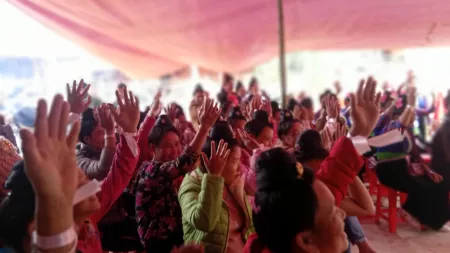“I feel stronger and more comfortable. I identified types of economic, physical, and emotional violence and know who can help me when I am in violent situation.”
That’s the difference for one GBV survivor between having a network and support, and bearing the burden of violence alone. Community change agents, savings groups (VSLAs), and reconciliation committees at the community level all helped make this change by creating networks where women and men support each other.
Another survivor says, “Women now live more confidently, they are not pressured to speak out about their experiences of violence, and are not afraid of being talked about anymore.”
Changes are bigger than that. “[L]ife has changed clearly after having the project, especially the change in the perception of the wife and husband roles in the family. For example, men now do housework, discuss family matters and make decisions together with their wives. Women are more exposed to society and actively participate in the social groups, therefore, they are more confident because they understand that men and women are equal, women have the same rights as men.”
The Stand Up, Speak Out project in Vietnam ran from 2018-2022 in Vietnam with $618,100 in funding from the European Union. It reached 9,199 people directly, including 5,522 women. The project partnered with many levels of the Vietnamese government, and with Light. It focused on breaking the silence around GBV in ethnic minority communities.
What changed?
- Women experience less violence. Women experience of violence was cut in half, from 66% in 2018 to 33% in 2022. Not only that, 98% of women and 99% of men believe that violence has dropped in their communities since the project came.
- Women are less likely to accept violence. Women are 4 times more likely to reject violence as acceptable, from 9.7% at the beginning of the project, to 43% at the end. One official says, “Before 2019, women’s violence situation was hidden because they were shy and considered quarrels as normal, not violent.”
- People are rejecting negative stereotypes. The number of women who reject harmful gender stereotypes went from 72% at the beginning to 96% at the end. For men, the change was from 86% to 95%.
- Asking for help is more acceptable. The number of people who think that violence is purely a family matter, and women should not ask for help dropped. Now, 86% of women and 72% of men say that violence should not be kept hidden in the family.
- It’s easier to get help. The number of women who know how to report violence went from 75% to 89%. One community member who is part of a reconciliation team says, “Women are bolder in speaking out to the reconciliation team because their perception of GBV has changed. In addition, we have encouraged and told them that when they experience violence, they can find the reconciliation team.”
- Dialogues make a difference. Women who attended all of the sessions on violence were HALF as likely to experience violence as women who only attended some sessions.
- The model is scaling. The Department of Justice is taking on the reconciliation committee model the project started and scaling it to new districts—adding 1,600 reconciliation teams to help resolve issues of violence in communities.
How did it happen?
- Build networks and solidarity for response. Women said they “felt relieved and got much emotional support” from their savings groups. 95% of women and 83% of men in savings groups wanted to participate in GBV events and learning—beating the 80% target the project sent.
- Help communities build response skills. The project set up reconciliation committees at the local level that drew from a variety of local leaders and officials. Those community-based groups provided 49% of the services to end GBV for community members in the project. Community members who run “reliable addresses”—safe spaces in someone’s home where a person can go to report and seek help—"have gained the trust of the people and they themselves have a desire to help the people in their community”
- Strengthen formal services. Change agents in the project (67% of whom were women) felt that they had improved their skills, and that they are actually using the new skills in their work and their lives. One man service provider says, “I have received training on GBV and have become more confident in helping others. I have already supported 3 cases of violence. “
- Engage men and boys. 84% of men joined GBV dialogue sessions, and 83% joined community activities. One man says, “I have also changed my perception, for example, I thought that scolding is normal, now I know it is not. I know how to share housework with my wife.”
Want to learn more?
Check out the project evaluation.
